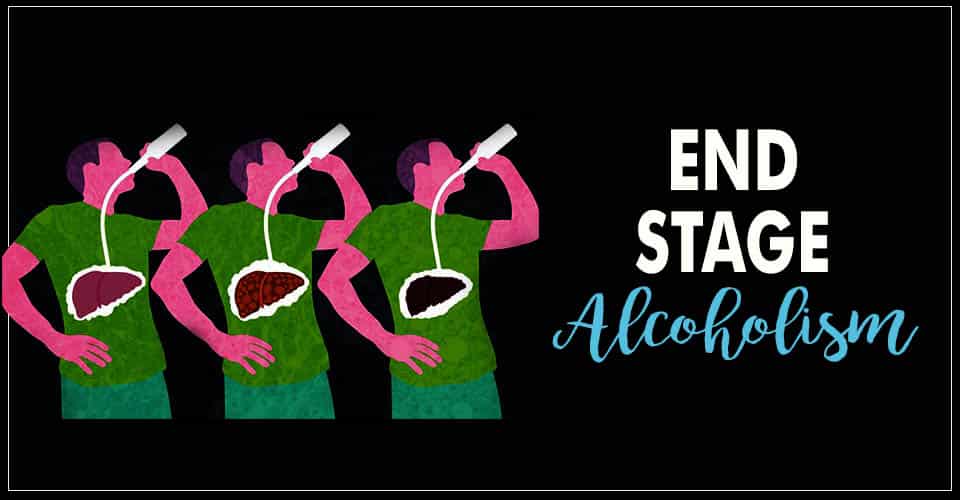End stage alcoholism is the final stage of alcohol addiction, which occurs after prolonged and excessive alcohol abuse. At this stage, the patient’s mental and physical health is severely impacted, and he/she may experience a range of debilitating symptoms. It is a critical condition where immediate medical attention is necessary to prevent further damage and begin the journey toward recovery.
What Is End Stage Alcoholism?
End stage alcoholism is the most severe form of alcohol addiction, generally comprising a full-blown alcohol use disorder (AUD). It occurs when an individual has been drinking heavily 1 US Department of Health and Human Services. (2016, November). THE NEUROBIOLOGY OF SUBSTANCE USE, MISUSE, AND ADDICTION. Nih.gov; US Department of Health and Human Services. Available from: https://www.ncbi.nlm.nih.gov/books/NBK424849/ for an extended period of time, causing significant physical and psychological damage 2 Sullivan, E. V., Harris, R. A., & Pfefferbaum, A. (2010). Alcohol’s effects on brain and behavior. Alcohol research & health : the journal of the National Institute on Alcohol Abuse and Alcoholism, 33(1-2), 127–143. .
It is also known as late-stage alcoholism, as it follows behind the early and middle stages of alcoholism 3 Rapsey, C. M., Wells, J. E., Bharat, M. C., Glantz, M., Kessler, R. C., & Scott, K. M. (2019). Transitions Through Stages of Alcohol Use, Use Disorder and Remission: Findings from Te Rau Hinengaro, The New Zealand Mental Health Survey. Alcohol and alcoholism (Oxford, Oxfordshire), 54(1), 87–96. https://doi.org/10.1093/alcalc/agy069 and is considered the last of the disorder’s phases.
The prognosis for this stage of alcoholism is poor, as individuals living with end stage alcoholism tend to develop life-threatening physical and mental health symptoms, as well as experience a shortened lifespan.
Phases of alcoholism
The common phases of alcoholism include:
- Social drinking, or drinking occasionally and experimenting with alcohol
- Binge drinking, or consuming excessive alcohol in bouts in order to get drunk
- Heavy drinking, or consuming excessive alcohol on a weekly basis
- Alcohol dependency, or developing a tolerance and psychophysiological dependence on excessive alcohol use
- Alcoholism, or addiction to alcohol
- End-stage alcoholism, or developing dangerous health and mental conditions in addition to alcohol abuse
Read More About Alcoholism Here
Symptoms Of End Stage Alcoholism
End stage alcoholism is chiefly characterized by a range of physical and mental health symptoms 4 McKay, J. R., & Hiller-Sturmhofel, S. (2011). Treating alcoholism as a chronic disease: approaches to long-term continuing care. Alcohol research & health : the journal of the National Institute on Alcohol Abuse and Alcoholism, 33(4), 356–370. , including:
- Liver damage
- Damage to brain cells and areas
- Anxiety and restlessness
- Malnutrition and vitamin deficiencies
- Severe depression and anxiety
- Chronic fatigue
- Hallucinations
- Weakened immune system
- High blood pressure
- Increased risk of heart attack or stroke
- Seizures and tremors
Read More About Alcohol And Mental Health
Withdrawal In Severe Alcoholism
When heavy drinkers suddenly decrease their alcohol consumption or abstain completely, they may experience a range of physical and psychological symptoms known as alcohol withdrawal (AW) 5 Becker H. C. (2008). Alcohol dependence, withdrawal, and relapse. Alcohol research & health : the journal of the National Institute on Alcohol Abuse and Alcoholism, 31(4), 348–361. .
The severity of AW can vary from mild to life-threatening, depending on the individual’s level of alcohol dependence and other factors. Symptoms of alcohol withdrawal 6 Alcohol withdrawal syndrome: how to predict, prevent, diagnose and treat it. (2007). Prescrire international, 16(87), 24–31. can include:
- Tremors
- Sweating
- Fever
- Confusion
- Anxiety and restlessness
- Nausea
- Vomiting
- Insomnia
- Headaches
- Hallucinations
- Seizures and body aches
- Delirium tremens (DTs) 7 Rahman, A., & Paul, M. (2018, November 18). Delirium Tremens (DT). Nih.gov; StatPearls Publishing. Available from: https://www.ncbi.nlm.nih.gov/books/NBK482134/ , a severe form of alcohol withdrawal
These symptoms typically emerge within hours to a few days after the last drink and can last for several days or even weeks. People experiencing severe withdrawal symptoms may require immediate medical attention and hospitalization to manage the symptoms and prevent complications.
Health Conditions Associated With End Stage Alcoholism
Research 8 Shield, K. D., Parry, C., & Rehm, J. (2013). Chronic diseases and conditions related to alcohol use. Alcohol research : current reviews, 35(2), 155–173. associates the common physical and mental health conditions with end-stage alcoholism:
- Liver diseases, like cirrhosis, hepatitis, and liver failure
- Chronic Pancreatitis
- Cardiovascular diseases (CVD), such as high blood pressure, arrhythmias, and cardiomyopathy
- Gastrointestinal problems, like gastritis, ulcers, and esophageal varices
- Malnutrition and vitamin deficiencies, especially Wernicke-Korsakoff syndrome
- Neurological disorders, such as peripheral neuropathy, ataxia, and dementia
- Increased risk of infections like pneumonia and tuberculosis
- Increased risk of certain cancers, such as liver and esophageal cancer
- Mental health conditions, like depression, psychosis, personality disorders, etc.
- Alcohol withdrawal symptoms like seizures and delirium tremens
Diagnosing End Stage Alcoholism
Diagnosis of end-stage alcoholism is included within the diagnosis of full-blown alcohol use disorder (AUD) in the Diagnostic and Statistical Manual of Mental Disorders (DSM-5).
To be diagnosed, patients who screen positive for binge drinking or heavy alcohol use must experience at least two of the 11 outlined symptoms 9 National Institute on Alcohol Abuse and Alcoholism. (2017). Alcohol Use Disorder: A Comparison Between DSM–IV and DSM–5 | National Institute on Alcohol Abuse and Alcoholism (NIAAA). Nih.gov. Available from: https://www.niaaa.nih.gov/publications/brochures-and-fact-sheets/alcohol-use-disorder-comparison-between-dsm within a 12-month period.
The diagnosis of end-stage alcoholism typically involves a comprehensive evaluation of the patient’s physical, psychological, and medical histories by a healthcare provider or addiction specialist. Treatment plans are commonly formulated and customized 10 Caputo, F., Domenicali, M., & Bernardi, M. (2019). Diagnosis and Treatment of Alcohol Use Disorder in Patients With End-Stage Alcoholic Liver Disease. Hepatology (Baltimore, Md.), 70(1), 410–417. https://doi.org/10.1002/hep.30358 in accordance to:
- The severity of the symptoms of alcoholism
- The presence of comorbid conditions
- The presence of advanced alcohol-related health problems such as cirrhosis, liver failure, or other alcohol-related complications
Treatment For End Stage Alcoholism
Common treatment processes 11 Frazier, T. H., Stocker, A. M., Kershner, N. A., Marsano, L. S., & McClain, C. J. (2011). Treatment of alcoholic liver disease. Therapeutic advances in gastroenterology, 4(1), 63–81. https://doi.org/10.1177/1756283X10378925 involved in end-stage alcoholism are as follows:
- Medically supervised detoxification
- Inpatient or outpatient addiction treatment programs
- Behavioral therapies, counseling, and support groups
- Medications to manage alcohol cravings and prevent relapse
- Liver transplantation for those with end-stage liver disease
Read More About Treatment For Alcoholism Here
Recovery From End Stage Alcoholism
Recovering from end stage alcoholism is a difficult journey 12 Venner, K. L., Matzger, H., Forcehimes, A. A., Moos, R. H., Feldstein, S. W., Willenbring, M. L., & Weisner, C. (2006). Course of recovery from alcoholism. Alcoholism, clinical and experimental research, 30(6), 1079–1090. https://doi.org/10.1111/j.1530-0277.2006.00121.x that involves multiple treatment options and ongoing support.
Long-term addiction treatment programs can help manage cravings and prevent relapse, supplemented by nutritional support and management of comorbid medical conditions. Lifestyle changes, such as avoiding triggers and engaging in healthy activities, are important for maintaining sobriety.
Addressing underlying emotional and psychological issues can also aid in recovery. With the right treatment and support, people with end-stage alcoholism can achieve sobriety and lead fulfilling lives, but ongoing monitoring and follow-up care 13 Sterling, S. A., Palzes, V. A., Lu, Y., Kline-Simon, A. H., Parthasarathy, S., Ross, T., Elson, J., Weisner, C., Maxim, C., & Chi, F. W. (2020). Associations Between Medical Conditions and Alcohol Consumption Levels in an Adult Primary Care Population. JAMA network open, 3(5), e204687. https://doi.org/10.1001/jamanetworkopen.2020.4687 are essential to prevent relapse and address new complications or existing medical or mental health issues.
Takeaway
End stage alcoholism is characterized by severe physical and mental health impairment. However, it is essential to understand that alcohol dependence is a treatable medical condition, even if recovery from end-stage alcoholism is challenging.
Better treatment outcomes are attainable at any stage of alcohol addiction, given appropriate and timely interventions. In fact, with the right support, determination, and treatment, individuals can lead healthy and fulfilling lives in recovery.
At A Glance
- End-stage alcoholism is the final stage of alcohol addiction, resulting from prolonged and excessive alcohol abuse.
- Signs of end-stage alcoholism include liver damage, anxiety, restlessness, malnutrition, depression, hallucinations, weakened immune system, and increased risk of heart attack or stroke.
- Diagnosis involves a comprehensive evaluation of the patient’s physical, psychological, and medical histories.
- Treatment options include medically supervised detoxification, inpatient or outpatient addiction treatment programs, behavioral therapies, medications, nutritional support, etc.
- Recovery from end-stage alcoholism is challenging but attainable with the right treatment and support.
Frequently Asked Questions (FAQs)
1. What happens in end-stage alcoholism?
In end-stage alcoholism, the affected patient’s mental and physical health is severely impacted, and he/she may experience a range of debilitating symptoms that require immediate medical attention.
2. How long does end-stage alcoholism last?
End-stage alcoholism lasts for a period of 12 months, after which, if left untreated, the affected person develops fatal physical and mental health symptoms.
3. What is Wernicke-Korsakoff syndrome?
Wernicke-Korsakoff syndrome is a neurological disorder caused by the lack of vitamin B1 or thiamine. Associated with the later stages of severe alcoholism, it damages nerve cells in the brain and spinal cord, as well as the brain region involved with memory.
4. What is the last step in recovery from alcoholism?
The final stage of recovery in alcoholism is termination, wherein the alcoholic is sober, has no cravings for alcohol, and experiences no threat of relapse. However, as alcoholism is a chronic relapsing disorder, even long-term sobriety can be marked by impulsive and dysfunctional behaviors associated with alcohol use.
















My sister in law husband is a heavy streight vodka drinker. Been in and out of the hospital said he was a stage 4 . Today I picked up Susie his wife . To take her to the dr. And grocery shopping. We were gone from 7 30 to1 . She was telling me . He has been drinking for 3 days. Without eating. When I took her home we thought he was passed out from drinking. Wouldn’t wake up. After we left an hr later she called us and said he woke up and know her oxy 15 out of her hand. She said he was already on the floor. He picked up 9 and put them in his mouth. Few min late4 his face started sagging. Then one eye went to the back of his head other looking streight. She said he would breath every 15 second. When he did breath it was google breathing. She called 911 they gave him nor cam . And saw he wasn’t breathing write put something down his throat. Took him to the hospital. Can you tell me if he will make it.